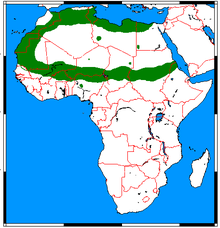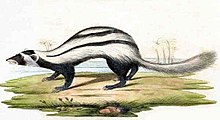Libyan striped weasel
| Libyan striped weasel | ||||||||||||
|---|---|---|---|---|---|---|---|---|---|---|---|---|

Bleached specimens of the Libyan striped weasel in a museum |
||||||||||||
| Systematics | ||||||||||||
|
||||||||||||
| Scientific name | ||||||||||||
| Ictonyx libyca | ||||||||||||
| ( Hemprich & Ehrenberg , 1833) |

The Libyan weasel ( Ictonyx libyca , Syn .: Poecilictis libyca ) is a species of predator from the family of the marten (Mustelidae) living in Africa . It is closely related to the Zorilla ( Ictonyx striatus related).
features
Libyan striped weasels resemble the skunks in their outward appearance , but they are not particularly closely related to them. Their fur is colored white on the upper side and on the flanks and has some black longitudinal stripes that are not clearly delimited from the white zones, the underside is black. The head is also black and has a white banding. The relatively short tail is white and bushy. Its tip is black. Libyan striped weasels reach a head body length of 20 to 26 centimeters, plus the 11.5 to 18 centimeters long bushy tail, the weight varies between 200 and 600 grams. Adult males are slightly larger than the females. The head is small, the muzzle is short. The females have four pairs of teats.
The tooth formula is: I3 / 3, C1 / 1, P 3/3, M 1/2.
Habitat and way of life
Libyan weasels are native to northern Africa. Their distribution area extends from Morocco and Mauritania to Egypt and Sudan . Their habitat are stony, dry areas on the edge of the Sahara with sparse vegetation, and sand dunes on the coasts. There are four subspecies:
- Ictonyx libyca libyca , Morocco, Algeria, Libya, Tunisia
- Ictonyx libyca multivittata , eastern Chad and central Sudan
- Ictonyx libyca oralis , Egypt, northern Sudan, Eritrea
- Ictonyx libyca rothschildi , Mauritania, Senegal, Mali, Burkina Faso, Niger, Nigeria
These animals are solitary, nocturnal and spend the day in self-dug burrows. They feed on rodents , small birds , lizards and insects . The prey is tracked down with the sense of smell and hearing and, if necessary, dug up with the front paws. In the event of a threat, like the skunks, they can chase the attacker away with the foul-smelling secretion from their anal glands . One to three young animals are born between January and March. At birth, they weigh about 5 grams, are blind and covered with short hair. After five weeks they are eating solid foods, and by two months of age they weigh about 250 grams.
Danger
Libyan weasels are likely to be widespread and are not endangered species. Accordingly, they are listed by the International Union for Conservation of Nature ( IUCN ) as Least Concern on the Red List of Endangered Species .
literature
- Ronald M. Nowak: Walker's Mammals of the World . Johns Hopkins University Press, 1999 ISBN 0801857899
supporting documents
- ↑ a b c d Don E. Wilson , Russell A. Mittermeier : Handbook of the Mammals of the World - Volume 1 Carnivores. Lynx Editions, 2009, ISBN 978-84-96553-49-1 . Page 637.
- ↑ Ictonyx libycus in the endangered Red List species the IUCN 2009. Posted by: Hoffmann, M., Cuzin, F. & de Smet, K., 2008. Accessed January 24 of 2010.
